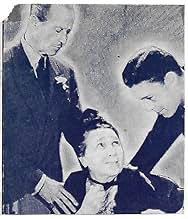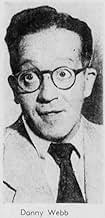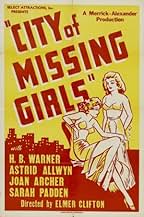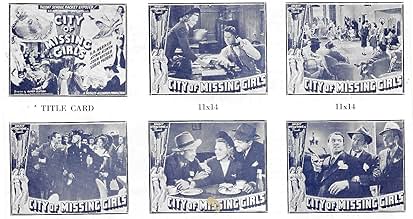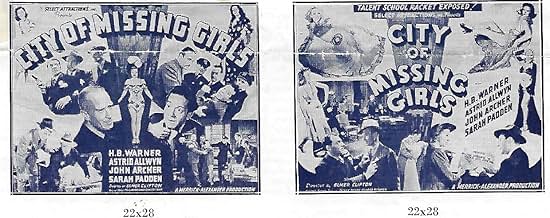Füge eine Handlung in deiner Sprache hinzuThere's an epidemic of missing girls in the city. The new assistant district attorney has to figure out what's going on before he loses his job, especially with a nosy reporter making his li... Alles lesenThere's an epidemic of missing girls in the city. The new assistant district attorney has to figure out what's going on before he loses his job, especially with a nosy reporter making his life difficult.There's an epidemic of missing girls in the city. The new assistant district attorney has to figure out what's going on before he loses his job, especially with a nosy reporter making his life difficult.
- Regie
- Drehbuch
- Hauptbesetzung
Kathryn Crawford
- Helen Whitney
- (as Katherine Crawford)
Gale Storm
- Mary Phillips
- (as Gail Storm)
Lassie Lou Ahern
- Nightclub Performer
- (Nicht genannt)
Jack Chefe
- Apartment House Manager
- (Nicht genannt)
Donald Curtis
- Reporter
- (Nicht genannt)
Dorothy Granger
- Showgirl
- (Nicht genannt)
Lloyd Ingraham
- District Attorney Fowler
- (Nicht genannt)
Ralph Peters
- Reporter
- (Nicht genannt)
Empfohlene Bewertungen
Having seen H. B. Warner as a character player in dozens of films, i was pleasantly surprised to see him starring in this crime-exploitation film about the white slave trade. I was also deeply impressed with his ability to carry the complex role of a poetic, philosophical police captain on the verge of retirement with such presence during the course of what otherwise would seem to have been destined to be a routine crime drama.
Alas, being a post-code movie, the white slave trade aspect of the plot is only understandable as a subtext, but there are plenty of other intriguing moments in the movie that will make B-film enthusiasts sit up and say, "Wow." For me, the gymnastic dance featuring a pair of uncredited twin teen girls was one such moment. Where did they FIND such unusual talent? Who were those young, incredibly athletic, giggling twins? We'll probably never know.
And then there was the scene in which H. B. Warner, previously seeming to be frail, distracted, and ready for the scrap heap of life, suddenly LEAPED INTO THE AIR and jumped into his bed feet first! What the heck!? That was truly replay-worthy.
This is not a great film, of course, but since it is available at bargain prices, old film buffs will certainly get their money's worth if they take the time to seek it out and watch it.
Alas, being a post-code movie, the white slave trade aspect of the plot is only understandable as a subtext, but there are plenty of other intriguing moments in the movie that will make B-film enthusiasts sit up and say, "Wow." For me, the gymnastic dance featuring a pair of uncredited twin teen girls was one such moment. Where did they FIND such unusual talent? Who were those young, incredibly athletic, giggling twins? We'll probably never know.
And then there was the scene in which H. B. Warner, previously seeming to be frail, distracted, and ready for the scrap heap of life, suddenly LEAPED INTO THE AIR and jumped into his bed feet first! What the heck!? That was truly replay-worthy.
This is not a great film, of course, but since it is available at bargain prices, old film buffs will certainly get their money's worth if they take the time to seek it out and watch it.
This is a very low budget B picture which is saved from being a waste of time by surprisingly good acting. The film is 98% shot in a studio with the most basic possible sets. The film did provide an opportunity for Gale Storm, aged 19, to appear in her third feature film (she started in movies only the year before). She would later become famous in America and become something of a 'national treasure' in the hit television series MY LITTLE MARGIE (1952-1955), in which she played Little Margie. Since the series ran to 126 episodes, there was no one in America who had not seen her and taken her to their hearts by the time that was over. And from 1956 to 1960 she continued to ride on her wave of national popularity with her own series, THE GALE STORM SHOW. This film featured H. B. Warner, a well-known and solid performer of the old school, as a police captain, and an extremely lively and cheerful Astrid Allwyn, who does a very good job at holding the film together and keeping us interested. She plays very well against John Archer, as there is chemistry in their jokey romance. The film is a mystery, in that several young girls from the city have disappeared, and no one can trace them. Two have been found dead, so that there is obviously something sinister going on. Whodunnit and who is doing it? That's what everyone wants to know. But it is not easy to find out. A rainy afternoon film.
An assistant DA tries to track the whereabouts of missing girls, leading into a tangled web of corruption.
With that suggestive title and sleaze director Elmer Clifton, I was expecting maximum titillation. Well, there is some peek-a-boo at The Crescent School of Fine Art, where the half-clad dancers somehow manage to all be female. No doubt, if it weren't for the censors, the "school" would be called Gateway to Hookerland, but then this is a commercial product.
Not surprisingly, it is a cheap undertaking by quick-buck producers. Still, the cast is much better than the material, especially the sparkly Allwyn and the smoothly slick Van Zandt, who's especially impressive as an egotistical gangster. His sarcastic exchanges with DA Horton (Archer) may well be the film's dramatic highlight. These main players may not be exactly household names but they do lend edge to what could have been merely a listless payday. Impressive too is old-timer HB Warner who's about as relaxed before the camera as anyone I've seen. Still, it's a long way from Jesus in King of Kings (1927), a silent screen classic. I imagine he was added for marquee value. Then too, catch malt-shop Gale Storm in a small but appealing part.
Anyway, it's a rather complex plot so you may need to keep notes. Still, the large cast does about as well with the tacky material as can be expected, and is not without points of interest.
With that suggestive title and sleaze director Elmer Clifton, I was expecting maximum titillation. Well, there is some peek-a-boo at The Crescent School of Fine Art, where the half-clad dancers somehow manage to all be female. No doubt, if it weren't for the censors, the "school" would be called Gateway to Hookerland, but then this is a commercial product.
Not surprisingly, it is a cheap undertaking by quick-buck producers. Still, the cast is much better than the material, especially the sparkly Allwyn and the smoothly slick Van Zandt, who's especially impressive as an egotistical gangster. His sarcastic exchanges with DA Horton (Archer) may well be the film's dramatic highlight. These main players may not be exactly household names but they do lend edge to what could have been merely a listless payday. Impressive too is old-timer HB Warner who's about as relaxed before the camera as anyone I've seen. Still, it's a long way from Jesus in King of Kings (1927), a silent screen classic. I imagine he was added for marquee value. Then too, catch malt-shop Gale Storm in a small but appealing part.
Anyway, it's a rather complex plot so you may need to keep notes. Still, the large cast does about as well with the tacky material as can be expected, and is not without points of interest.
City of Missing Girls is an interesting post-Hays Code mystery film. It verges on exploitation subject matter but seeing as it was made after the stringent Code censorship rules you could be forgiven for not even noticing. The story is basically about an unscrupulous club-owner who sends show-girls off to lives of prostitution. Pretty racy stuff for the times but the vice material is only ever really alluded to. This was seriously taboo material in the 40's hence this enforced approach.
The film itself is an efficient enough, if unremarkable, example of genre film-making of the time. The focus is strictly on the mystery side of the story, with thrills and suspense almost completely absent. Still it's worth checking out as something of a curiosity piece, seeing as it was quite unusual in the 40's for such a standard mystery film to incorporate any exploitation material at all. So at the very least this movie has this one unusual angle to differentiate it from most of its peers.
The film itself is an efficient enough, if unremarkable, example of genre film-making of the time. The focus is strictly on the mystery side of the story, with thrills and suspense almost completely absent. Still it's worth checking out as something of a curiosity piece, seeing as it was quite unusual in the 40's for such a standard mystery film to incorporate any exploitation material at all. So at the very least this movie has this one unusual angle to differentiate it from most of its peers.
Girls are going missing and a DA and veteran cop team up to expose the rackets that are set up to lure young girls in to a life of shame.
This film is more a curiosity than anything. My guess it was cheaply made and ran on the exploitation circuit for years. The music isn't even stock music, but is supplied by an organ that pumps out bridges between scenes.
How best to describe this movie? Its the type of movie that insomniacs prayed not to find on the Late Late Show because it was just interesting enough to keep them awake while it un-spooled. It wasn't good enough to actually wake them up, but it wasn't bad enough to put them out, rather its a film of the twilight between asleep and awake.
I'm of a similar mind, its not bad, but its not good. Its the sort of thing that just is. If you should run across it on TV you might want to try it, but I can't suggest searching it out.
5 out of 10
This film is more a curiosity than anything. My guess it was cheaply made and ran on the exploitation circuit for years. The music isn't even stock music, but is supplied by an organ that pumps out bridges between scenes.
How best to describe this movie? Its the type of movie that insomniacs prayed not to find on the Late Late Show because it was just interesting enough to keep them awake while it un-spooled. It wasn't good enough to actually wake them up, but it wasn't bad enough to put them out, rather its a film of the twilight between asleep and awake.
I'm of a similar mind, its not bad, but its not good. Its the sort of thing that just is. If you should run across it on TV you might want to try it, but I can't suggest searching it out.
5 out of 10
Wusstest du schon
- WissenswertesThis film received its earliest documented telecast Saturday 5 August 1944 on New York City's pioneer television station WNBT (Channel 1). Post-WWII television viewers got their first look at on the East Coast Wednesday 29 December 1948 on WATV (Channel 13) (New York City), and on the West Coast Wednesday 4 May 1949 on KPIX (Channel 5) (San Francisco).
- Zitate
King Peterson: Do you mind if I smoke?
Assistant D.A. James J. Horton: I don't care if you burn.
- VerbindungenReferenced in Kalter Hauch (1972)
Top-Auswahl
Melde dich zum Bewerten an und greife auf die Watchlist für personalisierte Empfehlungen zu.
Details
- Laufzeit
- 1 Std. 14 Min.(74 min)
- Farbe
- Sound-Mix
- Seitenverhältnis
- 1.37 : 1
Zu dieser Seite beitragen
Bearbeitung vorschlagen oder fehlenden Inhalt hinzufügen

